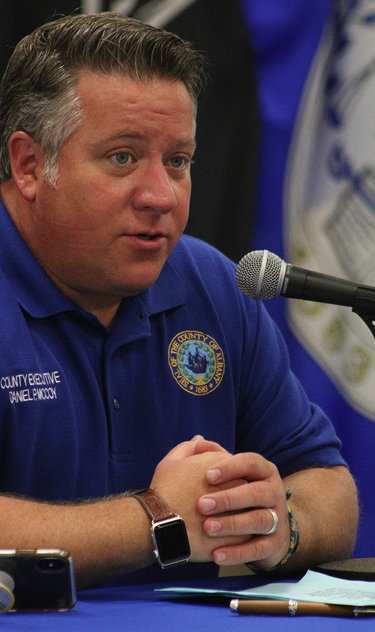County’s COVID uptick continues
ALBANY COUNTY — The county marked 17 new cases of COVID-19 on Saturday morning, continuing a week-long uptick in positive test results.
Seven of the new cases are linked to a Fourth of July party in several backyards on Hudson Avenue, bringing the total number of positives from that party to 22.
The gathering was attended by over 200 college-age people many of whom have not yet been tested. The health department has repeatedly urged anyone at the gathering to call and get tested for COVID-19.
Four of the 17 new cases were of health-care workers and two were travelers, said Albany County Executive Daniel Mccoy at his Saturday morning press briefing. The remaining four had contact with someone who was infected with the disease.
“It’s a ripple effect,” said McCoy of how coronavirus-2019 spreads.
He also advised people coming to Albany County from one of the 22 states listed by New York as having a high rate of COVID-19, “Stay in your place for 14 days. It’s not about you. It’s about the people around you.”
He had a similar message for those in the 20-to29 age group, like the Fourth of July party-goers, who he said were not wearing masks and were not staying six feet from others.
That age group has more infections than any other age group in Albany County. And its members often don’t get tested because they have no symptoms. “It’s not about you. It’s about the people around you …,” said McCoy. “You’re exposing everyone else and you’re keeping it here.”
McCoy went on, “I remember being that age. You’re invincible … You’re out having fun … Just social distance and wear a mask.”
Albany County now has 2,096 confirmed cases of COVID-19 with 644 residents under mandatory quarantine, up from 612 on Friday.
The five-day average for new daily positive cases has increased to 17.8 from 16.4 yesterday. Albany County currently has 87 active cases, up from 84 yesterday.
So far, since the beginning of the outbreak in mid-March, 6,368 county residents have completed quarantine, with 2,009 of them having tested positive and recovered.
Three county residents are now hospitalized with COVID-19 and the county’s hospitalization rate is now 0.14 percent.
So far, 122 county residents have died from COVID-19; the most recent death was on Thursday after a week’s hiatus.
Governor Andrew Cuomo released statewide numbers on Saturday morning that show a continuing decline in hospitalizations: 743, a decline of 22 from Friday. The number of daily deaths also continues to decline statewide. On Friday, 11 New Yorkers died of COVID-19 bringing the state’s death toll to 25,035.
Of the 69,817 test results reported in New York State on Friday, 754, or 1.08 percent, were positive. The Capital Region tied with the Southern Tier for the second-lowest rate at 0.7 percent. The North Country continues to have the lowest rate of the state’s 10 regions; it was 0.4 percent on Friday.
“As New York continues to show progress combatting COVID-19 with low hospitalizations and a low rate of positive cases, we remain alarmed by spikes in much of the country and the risk of a lack of compliance at home as the state pursues a phased, data-driven reopening,” Governor Andrew Cuomo said in a statement releasing Saturday’s data. “New Yorkers’ vigilance, courage, and adoption of basic behaviors — mask wearing, hand-washing, and social-distancing — has driven our ability to control the virus, and we have to continue on that path to success.”
McCoy said he didn’t know why, with the recent uptick in new cases in Albany County, the hospitalization rate was remaining so low, unlike in April and May. “It scares the hell out of me,” he said.
McCoy concluded, “I say to everyone, please get tested … It would help stop the spread.”


